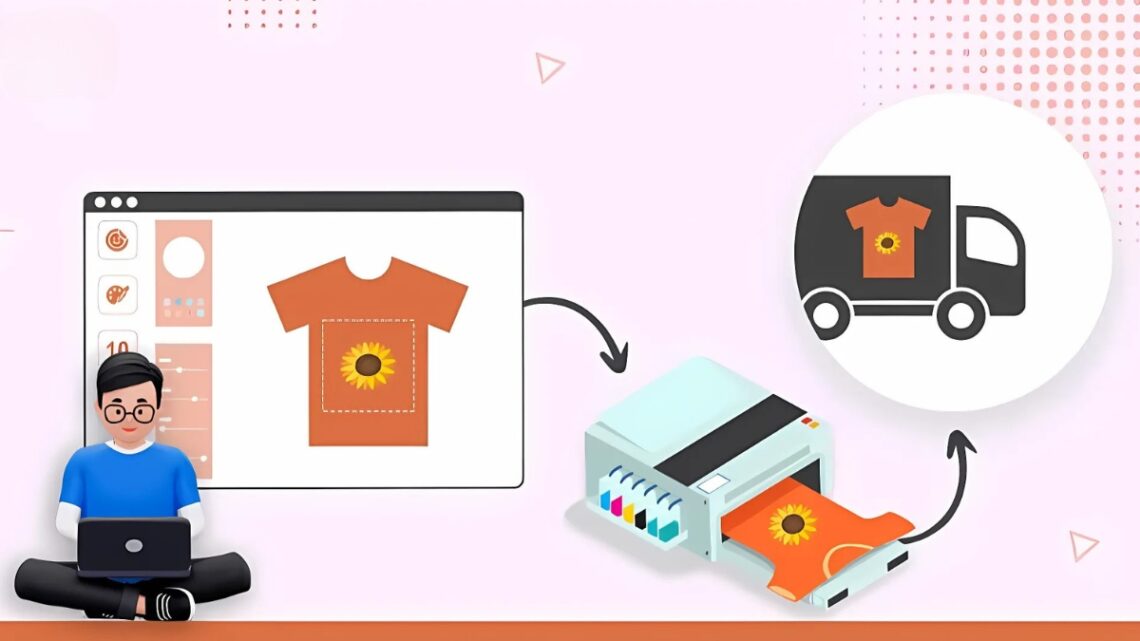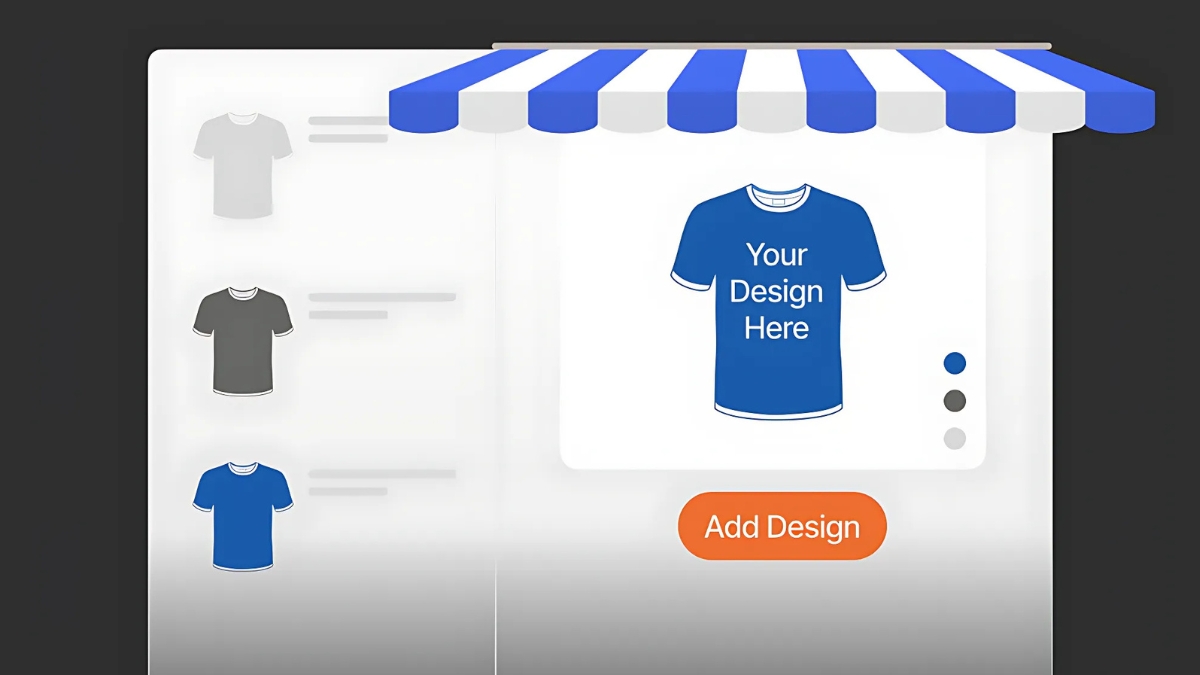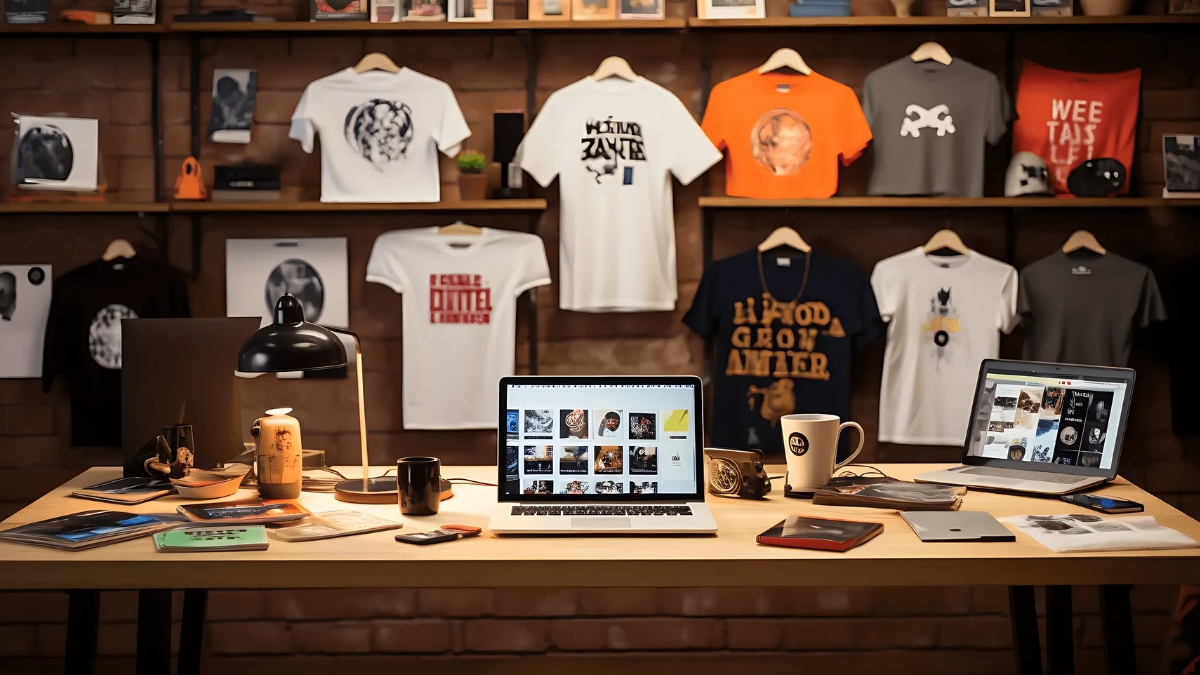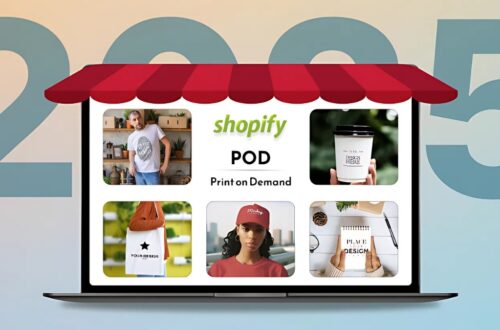
Multi-Platform Print on Demand Setup Guide 2025: Maximize Your POD Business Success
Did you know that the print-on-demand market is projected to reach $39.91 billion by 2030? As more entrepreneurs seek passive income streams, multi-platform POD businesses are becoming increasingly attractive. Whether you’re an artist, designer, or business owner, leveraging multiple platforms can significantly increase your reach and revenue potential. Let’s dive into everything you need to know to set up a successful multi-platform print-on-demand operation!
Understanding Print on Demand Fundamentals
You know, when I first stumbled into print-on-demand, I thought it was too good to be true. Here was this business model where I didn’t need to store inventory or buy expensive printing equipment! Basically, print-on-demand (POD) is a business model where products are only printed after a customer places an order. It’s like having a magical warehouse that creates products on demand – no upfront inventory costs, no garage full of t-shirts that might never sell.
I remember my first attempt at choosing a POD service – talk about overwhelming! After years of testing different providers, I’ve found that each major player has their sweet spot. Printful is like the BMW of POD – premium quality and pricing to match. Their color consistency is fantastic, which I learned the hard way after getting complaints about color variations from another provider. However, their prices can eat into your margins significantly.
Printify, on the other hand, is more like a marketplace of print providers. They often have better prices than Printful, but here’s a pro tip: always order samples from different print providers within their network. I once had a disaster with a print provider in their network that had terrible quality control, but after switching to a different provider within Printify, the quality has been rock solid.
SPOD (Spreadshirt’s service) is incredibly fast with shipping, often getting orders out within 24-48 hours. They’re particularly good for the European market. Gooten has some unique products that others don’t offer, but their shipping times can be a bit unpredictable in my experience.

Let’s talk profit margins – this is where many entrepreneurs stumble. When I started, I made the rookie mistake of pricing my products too low. Here’s what I’ve learned: for t-shirts, aim for at least a 40% profit margin after all fees. If a t-shirt costs $15 to produce, don’t sell it for $20 – you’re leaving no room for platform fees, advertising costs, and actual profit. I typically price my t-shirts at 2.5-3x the production cost.
For managing multiple platforms, you absolutely need the right tools. Personally, I swear by Ecommerce Automation to track orders across platforms. I also use Canva Pro for quick design modifications – trust me, paying for the pro version is worth it when you need to resize designs for different products quickly. One tool I wish I’d started using earlier is Order Desk – it’s been a game-changer for managing orders across multiple platforms and POD services.
The key to success in POD is understanding that it’s not just about creating designs and listing them. It’s about building systems. I use Google Sheets to track which designs are on which platforms and their performance. This might seem old-school, but it’s surprisingly effective and flexible.
These fundamentals might seem basic, but they’re crucial to get right. I’ve seen too many people jump into POD thinking it’s easy money, only to get overwhelmed by the complexity of managing multiple platforms and providers. Take the time to understand these basics, and you’ll save yourself a lot of headaches down the road!
Remember, POD is a marathon, not a sprint. Focus on building solid foundations with the right providers and tools, and the rest becomes much easier to manage.
Choosing Your Print on Demand Platforms
When I first dived into POD, I made the classic newbie mistake of trying to be everywhere at once. Trust me, that’s a recipe for getting absolutely nowhere! Now, after years of experience, I’ve developed a much clearer understanding of each platform’s unique characteristics.
Let’s start with Etsy, which has become my personal favorite for POD. What’s fantastic about Etsy is its built-in audience of buyers specifically looking for unique, customized items. Here’s something most people don’t realize – Etsy customers are typically willing to pay premium prices for the right products. I’ve found that my profit margins are consistently higher there compared to other platforms. However, there’s a catch – Etsy’s algorithm heavily favors shops with consistent sales and excellent customer service. You need to be super responsive and maintain at least a 95% positive review rate to really succeed there.
Amazon, through Merch by Amazon, is a completely different beast. The volume potential is incredible – I had one design that sold over 500 units in a month during Q4! But here’s the thing: Amazon is incredibly competitive, and their approval process can be frustratingly slow. They also have strict content policies that can be tricky to navigate. Pro tip: start with simple, text-based designs that clearly don’t violate any trademarks. I learned this the hard way after having several designs rejected early on.
eBay is often overlooked for POD, but it can be a goldmine for certain niches. I’ve found particular success with customized products like personalized family shirts or event-specific merchandise. The platform fees are higher than you might expect though – you’re looking at around 12.55% plus $0.30 per sale, which needs to be factored into your pricing strategy.
Now, let’s talk about standalone stores. Shopify has been a game-changer for my business, but it took me some time to figure out how to make it work. The monthly fees ($29 for basic plan) initially seemed steep when I wasn’t making many sales, but the ability to build your own brand and control the customer experience is invaluable. One thing I wish I’d known earlier – invest in good product photography and lifestyle images. They make a huge difference in conversion rates.

WooCommerce is great if you’re tech-savvy and want more control over your store. It’s technically free, but once you add all the necessary plugins and hosting costs, it can actually end up being more expensive than Shopify. I tried it for six months but found the maintenance requirements too time-consuming.
Here’s my current strategy for platform selection: I start new designs on Etsy to test market response. If they perform well, I expand to Amazon. Once I have a consistent seller, I add it to my Shopify store and drive traffic through targeted ads. This approach has helped me minimize risks while maximizing potential returns.
The key is understanding your target audience. For example, if you’re selling wedding-related products, Etsy should be your primary platform. For trend-based designs, Amazon is usually your best bet. If you’re building a brand with a specific niche focus, Shopify might be your best starting point.
Remember, it’s better to master one platform than to be mediocre on many. I spent my first year just focusing on Etsy, really learning the ins and outs of the platform, before expanding to others. This focused approach helped me build a strong foundation for my business.
One final piece of advice from my experience: don’t forget about platform-specific holidays and events. Each marketplace has its own peak seasons, and planning your launches around these can significantly boost your success rate.
Take your Etsy shop to the next level with Etsy Masterclass Downloads! These expert resources provide actionable tips on creating eye-catching listings, mastering SEO, and driving consistent sales. Learn how to attract loyal customers, set competitive prices, and build a standout brand. Perfect for beginners and seasoned sellers aiming to maximize their Etsy success. Start transforming your shop into a thriving business today!
Setting Up Your POD Infrastructure
Let me tell you about setting up a POD infrastructure – I’ve gone through this process multiple times, and there’s nothing quite like the feeling of seeing your first automated order flow through the system perfectly!
I remember staring at my computer screen, completely overwhelmed by all the integration options. Where do you even start? Well, after numerous trials and errors, I’ve developed a systematic approach that actually works. Let me break down what I’ve learned about setting up a rock-solid POD infrastructure.
First things first – platform integrations. Each platform has its own quirks, and boy, did I learn this the hard way! With Printful-Etsy integration, for example, I discovered that you need to set up your tax settings in Etsy before connecting it to Printful. I spent hours troubleshooting why my listings weren’t publishing, only to realize this simple step was missing. For Shopify integrations, always start by installing the POD provider’s app from the Shopify app store first, rather than trying to connect from the POD provider’s side.
Managing product catalogs across multiple channels used to be my biggest headache. I’d spend hours updating prices across different platforms, until I discovered the power of product information management (PIM) systems. Now, I use a combination of spreadsheets (for tracking) and automation tools to manage everything. Pro tip: create a master spreadsheet with all your product information, including SKUs, descriptions, and pricing formulas. This becomes your single source of truth.
Let me share a game-changing discovery about order fulfillment automation. You know those expensive automation platforms everyone recommends? Well, I found that for most POD businesses, you can achieve the same results using much simpler tools. I use a combination of Order Desk and Zapier to create automated workflows. For example, when an order comes in on any platform, it automatically creates a fulfillment order, sends order notifications, and updates inventory levels across all channels.

Speaking of inventory – sync solutions are crucial when you’re running a multi-platform operation. I learned this lesson after overselling a product that was out of stock with my supplier. Now, I maintain a buffer stock setting across all platforms and use automatic sync tools to prevent overselling. One important detail many people miss: set up “low stock” notifications at around 20% of your maximum stock levels. This gives you time to make adjustments before products go completely out of stock.
Here’s something that transformed my operation: setting up automated tracking number updates. I used to manually copy and paste tracking numbers – what a waste of time! Now, I have a system where tracking numbers automatically sync back to each marketplace and trigger customer notification emails. The key is to test these automations thoroughly with sample orders first – trust me on this one!
One aspect that often gets overlooked is error handling in your automation setup. You need a system to catch and alert you about failed automations. I set up email notifications for any orders that don’t process automatically, which helps me catch and fix issues before they become customer service problems.
Remember, your infrastructure needs to be scalable. What works for 10 orders a day might completely break down at 100 orders. I learned to build systems that can handle at least 10 times my current volume. This might seem like overkill at first, but you’ll thank yourself later when orders start rolling in!
The most important lesson I’ve learned about POD infrastructure? Keep it as simple as possible while still meeting your needs. It’s tempting to over-engineer everything, but sometimes the simplest solution is the most reliable. Start with the basics, test thoroughly, and add complexity only when absolutely necessary.
Design and Product Strategy
Back when I started, I made the classic mistake of designing what I thought was cool without any market research. Let’s just say those heavy metal cat designs weren’t exactly flying off the virtual shelves! Now I know better – proper niche research is absolutely essential. One of my best-performing niches came from noticing a gap in the market for sophisticated gardening-themed designs that appealed to older millennials. Who knew there were so many plant parents wanting to show off their hobby?
Here’s my tried-and-true process for niche research: I use a combination of Google Trends, Pinterest Trends, and good old-fashioned marketplace research. But here’s a tip nobody talks about – check Facebook groups in your potential niche. I spent two weeks just lurking in gardening groups before creating my first design in that niche, and the insights were invaluable. I noticed people constantly sharing inside jokes about plant addiction and “leaf therapy” – these became fantastic selling points for my designs.
When it comes to platform-specific listings, each marketplace needs its own approach. What works on Etsy bombs on Amazon, and vice versa. For example, on Etsy, I learned that longer, story-based descriptions with personal touches perform better. But on Amazon, it’s all about clear, concise bullet points and keyword optimization. I once had the same design listed on both platforms – the Etsy listing emphasized the handcrafted aspect and personal story behind the design, while the Amazon listing focused on product features and practical benefits.
Let’s talk about metadata – this is where I see so many POD sellers dropping the ball. Each platform has its own sweet spot for titles and tags. For Etsy, I discovered that front-loading your most important keywords in titles makes a huge difference. On Amazon, including size variations in your bullet points can significantly improve visibility. I keep a spreadsheet of high-performing keywords for each platform and regularly update it based on what’s actually driving sales.
Managing design assets became a massive headache until I developed a proper system. Now, I have a standardized naming convention for all my files (niche-design-variant-date) and use cloud storage with specific folders for each platform’s requirements. I learned this lesson after spending hours trying to find the right file version for a customer’s order modification request!

One of my biggest discoveries was about seasonal planning. I start preparing holiday designs at least 3-4 months in advance. This gives enough time for testing and optimization before the peak selling season hits. Last Christmas, I was ready with my designs in September, while many of my competitors were scrambling in November.
Here’s something most people overlook – the importance of mockup diversity. I used to just use the standard POD mockups, but then I started creating lifestyle mockups specific to each niche. My gardening designs started performing much better when I showed them in actual garden settings rather than just on plain white backgrounds.
Color variants are another game-changer. I always create at least three color variations of each successful design, but here’s the trick – I only list all variants on platforms where they’re performing well. No need to clutter your store with variations that don’t sell!
The hardest lesson I’ve learned about design strategy is that sometimes your personal favorite designs just don’t sell. You have to be willing to let go of designs that aren’t performing, regardless of how much you love them. Focus on what the data tells you – track your best-sellers and create more designs in that style or niche.
Remember, successful POD design isn’t just about creating pretty pictures – it’s about solving problems or fulfilling specific desires for your target audience. Every design should either solve a problem, express a personality, or capture a moment that’s meaningful to your niche market.
Marketing Your Multi-Platform POD Business
When I first started marketing my POD business, I thought I could just copy and paste the same marketing approach everywhere. Big mistake! Each platform has its own SEO quirks and buyer behaviors. For instance, on Etsy, I discovered that using conversational, long-tail keywords like “funny gardening gift for mom” performed way better than generic terms like “gardening t-shirt.” It took me months of testing and tweaking, but now my Etsy listings consistently show up on the first page for my target keywords.
Pinterest turned out to be my secret weapon for POD marketing. Here’s something most people don’t realize – Pinterest users are actually planning to buy, not just browsing! I create platform-specific pins for each product, but here’s the trick: I don’t just show the product. Instead, I create lifestyle images showing the product in use. My conversion rates tripled when I started showing real people wearing my designs in relevant settings.
Cross-promotion was a game-changer for my business, but you have to be smart about it. I include a small thank you card with each order that has a QR code leading to my Shopify store, offering a 10% discount on their next purchase. This strategy helped me gradually move customers from marketplace platforms to my own store, where the margins are much better.
Social media marketing really clicked for me when I stopped trying to be everywhere at once. I focused on Instagram and TikTok, creating behind-the-scenes content showing my design process and sharing customer photos. One of my TikTok videos showing how I package orders went viral – it wasn’t even a fancy video, just authentic content that resonated with people!
Email marketing was something I initially overlooked, thinking it wouldn’t work for POD. Was I ever wrong! I started building my list by offering a 15% discount on the first order, and now email marketing drives about 30% of my Shopify store sales. The key is segmentation – I send different emails to customers based on what they’ve purchased before. My plant-themed design customers get completely different content than those who bought my pet-related designs.
Customer retention became much easier once I started treating each sale as the beginning of a relationship, not the end. I keep a calendar of popular gifting occasions and send targeted emails about new designs. For example, if someone bought a Mother’s Day design, I make sure to reach out before other gifting holidays with relevant suggestions.

One of my biggest marketing wins came from user-generated content. I encourage customers to share photos wearing their purchases by offering a chance to be featured on our social media and a discount on their next order. The authentic photos and reviews have been worth their weight in gold for building trust with potential customers.
Here’s something that surprisingly worked well – creating platform-exclusive designs. I have certain designs that are only available on specific platforms, which gives me something unique to promote on each channel. This exclusivity angle has helped drive sales and create buzz around new releases.
I’ve learned that timing is everything in POD marketing. I start promoting holiday designs at least 2-3 months before the actual holiday. This seems early, but it gives enough time for the algorithms to recognize and start showing your products to the right audience.
The most important lesson I’ve learned about POD marketing? Consistency beats perfection every time. Regular, steady marketing efforts across all platforms yield better results than sporadic bursts of activity. It’s like tending a garden – regular care leads to better growth than occasional intensive effort.
Remember, successful POD marketing isn’t just about pushing products – it’s about building a brand that resonates with your target audience across multiple platforms. Take the time to understand each platform’s unique characteristics, and adapt your marketing strategy accordingly.
Financial Management and Scaling
Let me share my experience with managing the financial side of a multi-platform POD business – it’s an area where I learned some tough lessons that completely changed how I approach scaling!
I’ll never forget my first tax season running a POD business. I had sales scattered across five different platforms and absolutely no system for tracking expenses. What a nightmare! Now, I use QuickBooks Online to track everything, but here’s a pro tip I wish I’d known earlier: set up separate bank accounts for each platform’s revenue. This makes reconciliation so much easier come tax time, and you can quickly see which platforms are actually profitable.
Speaking of profitability – tracking expenses across platforms was a game-changer for my business. I used to think my Amazon store was my best performer until I actually broke down the costs. Between their fees, advertising costs, and lower margins, Etsy was actually generating better net profit despite lower gross sales. This discovery completely changed my scaling strategy.
Here’s something nobody tells you about POD finances – you need a solid cash buffer. I learned this the hard way during Q4 when advertising costs ate up my operating capital. Now I maintain at least two months’ worth of operating expenses in reserve, especially during peak seasons. This gives me the flexibility to scale up advertising when I spot opportunities without risking cash flow problems.
Tax considerations nearly gave me a heart attack in my first year! Each platform reports income differently, and some don’t report at all if you’re below certain thresholds. I now keep a dedicated spreadsheet tracking sales tax collected by state (super important if you’re selling on multiple platforms in the US). Pro tip: set aside 30% of your profit for taxes from day one. Better to have too much saved than too little!
When it comes to reinvestment, I follow what I call the 50-30-20 rule: 50% goes back into the business (mainly advertising and new designs), 30% goes to taxes, and 20% is profit. This approach has helped me grow sustainably without burning out my resources. During my first year, I tried to reinvest everything, but this left me stressed about personal income. Balance is key!
Outsourcing was a major turning point in scaling my business. I started with hiring a virtual assistant to handle customer service across all platforms. The cost seemed high at first – about $500 monthly – but it freed up so much time that I could focus on design and strategy. My sales actually increased by 40% in the three months after hiring help because I could focus on growth activities.

One of the biggest financial lessons I’ve learned is about advertising spend. I used to throw money at ads across all platforms simultaneously. Now, I test new designs with a small ad budget on one platform first. If they perform well, I scale up and expand to other platforms. This approach has cut my wasted ad spend by about 60%!
Design costs were another area where I had to get smart about scaling. Instead of trying to create everything myself, I now work with two reliable designers who understand my brand. Yes, it’s an extra expense, but the increased output and professional quality have more than paid for themselves in sales.
Here’s something crucial about scaling that often gets overlooked – systems and documentation. I spent an entire month creating standard operating procedures (SOPs) for everything from design uploads to customer service responses. It seemed like a waste of time initially, but these SOPs made it possible to train new team members quickly and maintain consistency across platforms.
Remember, scaling isn’t just about increasing sales – it’s about building sustainable systems that can handle growth without everything falling apart. Take the time to get your financial foundation solid before pushing for expansion. Trust me, it’s much easier to scale a well-organized business than to try organizing a business that’s scaling too fast!
And always keep detailed records of which strategies are working on each platform. What costs $100 to acquire a customer on Amazon might only cost $20 on Etsy. This kind of platform-specific data is gold when you’re deciding where to focus your scaling efforts.
Successfully managing a multi-platform print-on-demand business requires careful planning and the right tools, but the potential for passive income and business growth makes it well worth the effort. By following this comprehensive setup guide, you’ll be well-equipped to launch and scale your POD business across multiple platforms. Remember, start with one or two platforms and expand gradually as you master each channel. Ready to begin your print-on-demand journey? Get started with your first platform integration today!





